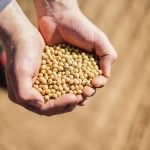Early last summer, Jim called me about his disappearing field of canola. He figured the seed was bad and he wanted some answers fast. I travelled to his farm west of Lethbridge, where he farms 5,000 acres of canola, barley, and wheat, to offer my help.
When I arrived, I found it did look like his field was disappearing because areas around the edge of the field had very few plants, or were bare. Most of the field seemed healthy with good stands of emerging plants, but it looked like his crop was shrinking around the edges, with some of these bald patches extending into the centre. When I took a closer look, I noticed the stems of the plants were broken off at the soil surface.
Read Also

Country Guide November editorial: The now, the next and the numbers
I must admit that when I was younger numbers mystified and frustrated me. In fact, my typically jovial grade six…
I had to consider wind, frost, disease and insects. I also asked Jim about speed of the seeder at seeding time, fertilizer rates, and seed treatment. I quickly determined wind and frost weren’t the culprits, as parts of the field were completely healthy and the temperature had not dipped below zero for the past two weeks.
Seeds were present in the soil and I found most of them had germinated because roots were forming, so poor germination, the speed of the seeder, and the rates of fertilizer were not causing the damage to Jim’s field.
I asked Jim about seed treatment and he’d used seed treated with Helix. When we dug in the soil and found no activity of wireworms or cutworms, I wondered if I was dealing with disease or another type of pest. I needed to do some more investigating.
I’d arrived at the field about 9 a. m. and it was still quite cool. I had a feeling I was dealing with a pest problem, but at that time in the morning I saw no sign of my suspect. Sure enough, when I returned to the field at 11 a. m. I found the culprits — flea beetles!
I took a closer look at the plants adjacent to good plant stands and I found they were showing signs of flea beetle feeding on the cotyledons and small leaves.
With this diagnosis, Jim went in right away with an insecticide to get rid of the infestation. Instead of his field being a write-off, as he thought it would be, his plants recovered and he was able to produce a good crop. Needless to say, Jim was very pleased.
I suggested next year he use one of the newer, longer-lasting, and more persistent seed treatments — giving him protection for another seven to 10 days against flea beetles. Also, scouting the perimeters of his fields in the spring as the crop is emerging is essential. If there are signs of flea beetle damage, Jim should go in and spray immediately with an insecticide to kill the insects. I also told Jim when spraying a herbicide, if there are signs of flea beetle damage it is good practice to spray the headlands of those fields to reduce the risk of damage.
It’s worth the extra effort to scout canola fields on a regular basis for flea beetle — or any type of — damage to the crop throughout the entire growing season. There are so many factors to consider when growing canola that paying attention to all the details of management and agronomics is vital to a good canola harvest.
Steve Leavitt is the director of operations for Richardson International in Lethbridge, Alta.














